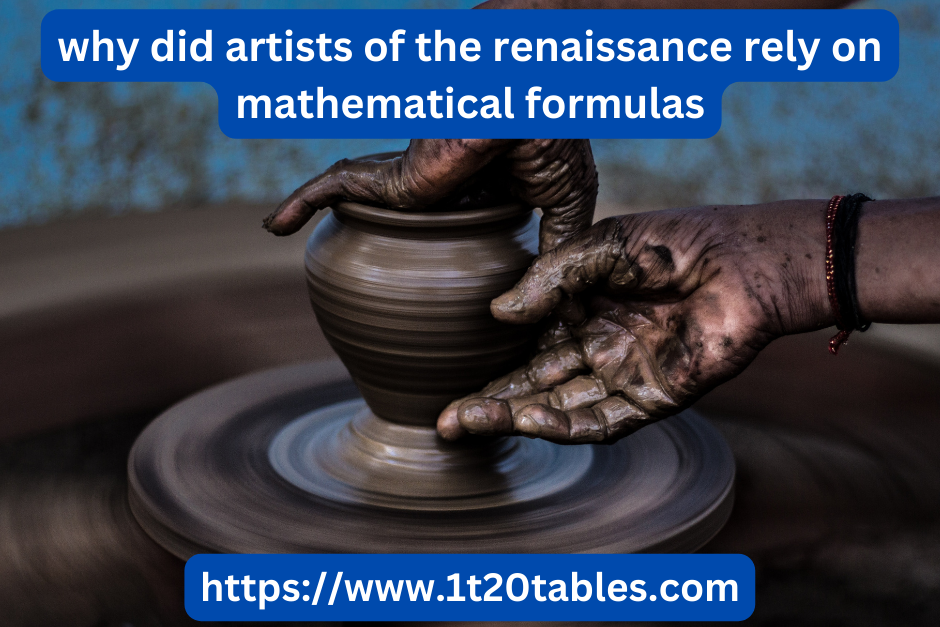The Intersection of Art and Mathematics: Unraveling the Role of Mathematical Formulas in Renaissance Art
Why did Artists of the Renaissance rely on Mathematical Formulas
I. Introduction
The Renaissance period was a time of profound change and rebirth in the fields of art, culture, and science. One of the most intriguing aspects of this era was the fusion of art and mathematics, particularly the use of mathematical formulas in creating masterpieces. This blog post delves into this fascinating intersection, exploring how and why artists of the Renaissance relied on mathematical principles to bring their visions to life.
II. The Renaissance: A Period of Artistic and Scientific Revolution
The Renaissance, a period spanning the 14th to the 17th century, was marked by a significant shift in artistic representation. Artists began to break away from the abstract forms of the Medieval period, embracing instead the Classical Greek/Roman art forms and the principles of Humanism. This shift was not just about aesthetics; it was a reflection of the broader cultural and intellectual revolution of the time.
III. The Mathematical Transformation of Art in the Renaissance
The use of mathematics in Renaissance art was a game-changer. Artists began to employ mathematical formulas and principles to create the illusion of three-dimensional space and shapes on a flat surface. This was achieved through the use of linear vanishing point perspective, a technique that gives the viewer the impression of depth and distance.
The pictorial frame also underwent a transformation during this period. Artists started to use a single vanishing point to create a more unified and realistic depiction of space. This shift in perspective allowed for more dynamic and engaging compositions, enhancing the viewer’s experience.
The Renaissance also saw the evolution of new artistic elements. Artists began to experiment with light and shadow, color, and form, using mathematical principles to guide their explorations. These techniques allowed them to achieve a greater level of naturalistic realism in their work.
IV. The Influence of Geometry in Renaissance Art
Geometry played a crucial role in the creation of Renaissance art. Artists like Leonardo Da Vinci and Piero Della Francesca studied geometry extensively, using it to create paintings, buildings, and sculptures with precise proportions and symmetry. This mathematical approach to art resulted in works that were both aesthetically pleasing and structurally sound.
V. The Medici Family: Patrons of Renaissance Art
The Medici family, the effective rulers of Florence for most of the Renaissance, were significant patrons of the arts. They commissioned numerous projects from artists like Michelangelo, fostering an environment where art and science could flourish. Their patronage played a crucial role in the development and propagation of the artistic techniques and styles characteristic of the Renaissance.
VI. The Impact of Mathematical Techniques on Artistic Realism
Renaissance artists used mathematical techniques to make their paintings more realistic. They employed perspective, light, and shadow techniques to create depth and a three-dimensional effect. They also used oil painting, a new medium that allowed for greater detail and realism.
VII. The Significance of the Human Figure in Renaissance Art
The human figure was of paramount importance in Renaissance art. Artists strived to depict the human form in a realistic and anatomically correct manner, often using mathematical principles to ensure accurate proportions. This focus on the human form was not just about physical accuracy; it was also a reflection of the humanist philosophy of the time, which placed a high value on human life and potential.
VIII. The Role of Mathematics in Art: Beyond the Renaissance
The fusion of art and mathematics did not end with the Renaissance. Today, artists continue to use mathematical principles in their work, whether consciously or unconsciously. Mathematics helps artistscreate balanced compositions, realistic forms, and visually pleasing patterns. It’s also used in modern fields like digital art and graphic design, where mathematical algorithms can generate complex and beautiful images.
IX. Conclusion
The Renaissance period was a pivotal time in the history of art, marked by a profound shift in how artists approached their craft. The use of mathematical formulas and principles played a significant role in this transformation, enabling artists to create works of unprecedented realism and depth. The impact of this fusion of art and mathematics continues to be felt today, influencing modern artistic techniques and styles.
The Renaissance serves as a powerful reminder of the potential for innovation and progress when art and science come together. As we continue to explore and push the boundaries of art in the 21st century, the lessons of the Renaissance remain as relevant as ever.
X. References and Further Reading
For those interested in delving deeper into the intersection of art and mathematics in the Renaissance, here are some recommended readings:
- “The Science of Art: Optical Themes in Western Art from Brunelleschi to Seurat” by Martin Kemp
- “The Power of the Center: A Study of Composition in the Visual Arts” by Rudolf Arnheim
- “The Geometry of Art and Life” by Matila Ghyka
- “De Divina Proportione (On the Divine Proportion)” by Luca Pacioli
Keywords: Renaissance Art, Mathematical Formulas, Geometry, Linear Vanishing Point Perspective, Pictorial Frame, Artistic Elements, Medici Family, Human Figure, Artistic Realism, Renaissance Period, Artistic Representation, Classical Greek/Roman Art Forms, Humanism, Illusionistic Painting Techniques, Naturalistic Realism, Michelangelo, Printmaking, Oil Painting, Sculpture, Architecture, Neoplatonic Ideal, Golden Ratio, Perspective and Light Techniques, Three-dimensional Space.

